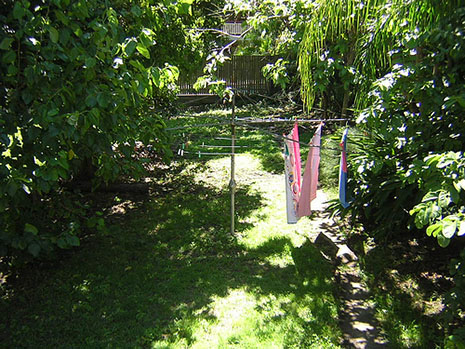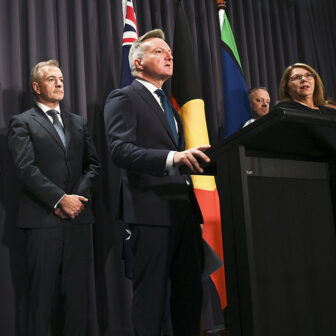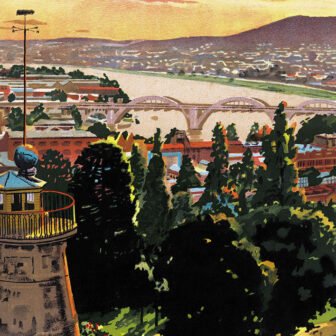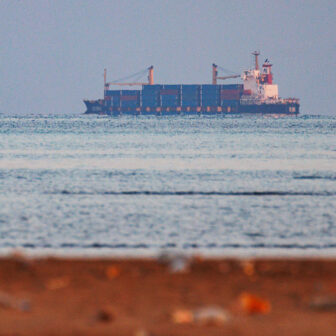Urban Nation: Australia’s Planning Heritage
By Robert Freestone | CSIRO | $79.95
The Life and Death of the Australian Backyard
By Tony Hall | CSIRO | $69.95
IN ALL the posturing about population growth over the past few months we’ve forgotten that affordable housing and pleasant living environments are key issues facing our cities. And it is not easy to do both at once. A lot of our cheapest rental housing is overcrowded, poorly maintained and in decrepit neighbourhoods. If you’re looking to buy it’s hard to find a new two-bedroom unit, let alone a new house, within twenty kilometres of our big cities for under $500,000. Commercial demographers and even Labor planning ministers hector us about making our cities denser. That’s good for property developers, investors, state government stamp-duty revenue, local council rate income and sometimes for public transport, but that’s it.
What kind of urban environments are we going to live in? Harry Triguboff, the multi-billionaire Meriton apartment developer, told us on Dick Smith’s Population Puzzle, screened on ABC1 just before the federal election, that if Sydney made its parks smaller it could fit in more housing. Where is the vision of a great city? Where is the public acknowledgement that Sydney’s foreshores and huge national parks give it character and liveability?
The dreams and achievements of Australia’s town planners are celebrated in Robert Freestone’s handsomely illustrated book, Urban Nation. The book began life as an attempt to advise the federal government on Australia’s planning heritage. Ironically, successive federal governments, including Labor, have so weakened the relevant body, the Australian Heritage Commission (now a mere “Council”), that Freestone’s heritage recommendations will fall on powerless ears.
Canberra takes centre stage in Freestone’s book as our only capital city created on the basis of an international planning competition, with leasehold land giving its successive planning authorities much more power than equivalent bodies enjoyed in the established cities. There, colonial and then state governments sold off most of the land into freehold title, securing one-off additions to the government coffers but losing much of their authority over land use.
Melbourne, Adelaide and Perth retain most of their original urban parklands, as some of the elegant plans in Freestone’s book attest. The banks of the Yarra River, much more vigorously alienated than the Sydney harbour foreshores, now see wharves and industry giving way to upper-middle-class apartment blocks. In terms of open space, Brisbane is in a much more parlous condition than Melbourne, which reveres its grand inner-city parks (though, despite vigorous protests, the Victorian government did build the Eastern Freeway right through the middle of the Yarra Bend Park). The largest bit of green space near the Brisbane CBD is a golf course, two-and-a-half times the size of the Botanic Gardens. The Bjelke-Petersen government made the problem even worse when it built a freeway on the northern bank of the Brisbane river.
Queensland also became the first Australian state to pass a Canals Act in 1958, and developers were invited to regard mangrove swamps as dirty, useless places to be cleaned up and built on. Oddly, Freestone is more interested in the town planning principles applied to the estates themselves, including the street layout, than he is in pointing the finger at generations of planners and architects who paid little or no attention to the massive ecological damage to which they effectively gave their blessing.
Apartment blocks and canal estates now dominate over two-thirds of the coast of the 200-kilometre city that extends from Noosa to Coolangatta, and only a few kilometres of shoreline has been left undeveloped. Insurance companies would withdraw cover from these potentially fragile properties if they could get away with it. Local governments from Gippsland to Bryon Bay have belatedly begun rejecting development applications on sand dunes, with a renewed consciousness that quite a few Gold Coast apartment blocks almost collapsed in the 1967 storms. (Only tons of emergency rock ballast kept the foundations from washing away.) If it weren’t for its great national parks, the coastline between Newcastle, Sydney and Wollongong would go the same way as Noosa to the Tweed. And it is only the absence of water views – because much of the foreshore is dominated by dirty chemical industry – that stops western Melbourne colliding with Geelong.
Australia’s major cities and their suburbs are degraded by constant traffic. Sydney has the nation’s most criticised public transport system, but at least it accounts for 15 per cent of all trips. Brisbane City Council area, where only 9 per cent of all trips are by public transport, now out-performs Melbourne, on 8 per cent, where farcical privatisation has wreaked havoc with perception and usage. Melbourne’s superb trams remain a potent urban symbol, but the train system simply isn’t reliable enough to get more people out of their cars. And all of this was compounded by Jeff Kennett’s decision to give Transurban the kind of monopoly that has made its toll-based freeways successful time savers.
In Brisbane, Campbell Newman, a lord mayor elected on a promise of eliminating gridlock, couldn’t get away with putting a toll back on the publicly owned Story Bridge. So when it came to the public–private partnership to build Australia’s longest roadway tunnel under the Brisbane River – the “Clem 7” – it didn’t have a monopoly on the route. With less than half its predicted usage, the $4.2 billion folly has left hapless shareholders asking sharp questions about the ethics of projecting traffic numbers. Brisbanites are flocking to the city’s excellent and ever-expanding busways.
FROM the 1950s to the 1980s potential suburban building blocks remained readily available in most of our cities, though in Sydney this meant giving up some of the green belt. But as councils and state governments charged more for roads, water and sewerage services, the price of land skyrocketed, exacerbated by strong demand. We’ve been stuck with high-priced housing ever since. Short of a depression, this won’t change. But, with many of our inner suburbs well served by public transport, apartment developers could bring cheaper purchase and rental options onto the market if they built apartments without on-site parking. They could also build apartments aimed at the likely users – often unrelated students, nurses, teachers, cleaners – not simply aimed at the investment market. Something as simple as having the toilet separate from the bathroom can make such housing more amendable to group households.
If the cities are in trouble, and our leisure spaces increasingly commercialised, can’t we simply retreat to our own backyards? As Tony Hall argues in The Life and Death of the Australian Backyard, 80 per cent of city dwellers still live in dwellings with backyards, where kids, pets, gardeners and aged relatives find activity and often solace. In a society besotted with screen-based infotainment there is a lot to be said for ready access to a backyard or a park.
Given the enormous pressures for new housing, it is important to appreciate, as Hall explains, that the traditional Australian backyard is disappearing more rapidly from new suburban estates on the urban fringe than it is from established suburbs. In what he terms the “roof to roof” estates, huge houses cover an increasing proportion of the land, whatever the lot size. Most of these houses have little or no provision for cross ventilation, lack eaves and require reverse-cycle airconditioning, by far the largest consumer of energy in houses like these (unless the media room is up and running twenty-four hours a day). Hall uses aerial photos to show that many of these new dwellings don’t have enough space for a vegetable garden – and if they have a pool they don’t allow enough space for the 20,000-litre tank they should have to keep it topped up. Instead they meet cosmetic sustainability regulations by shoving in a small, slimline tank.
The new outer-suburban settlements, so reliant on air conditioning and desal water, have huge carbon footprints, even before you calibrate in the two cars. Ironically, in the inner city, most of the new apartment blocks are just as carbon-intensive, with airconditioning, multiple car spaces and lifts to move people from floor to floor and to get you to your basement garage. The Seidler Riparian Plaza office and apartment block in Brisbane has seven floors of above-ground parking, giving every Porsche and BMW a water or city view. The rich in Australia house their cars well.
While the successive metropolitan plans that Freestone outlines in Urban Nation still direct the overall shape of our cities, more and more of the real planning decisions are being taken under the poisonous rubric of “infrastructure,” the cult word of the decade, and everybody wants more of it. Cost-benefit analyses, if they are undertaken at all, are done by self-interested engineering and accountancy firms and they almost always recommend the project proceed, whether it’s a tolled tunnel, a desalination plant or even a new rail line when making better use of existing lines often makes more sense. The proud statutory planning authorities that shaped our cities in the past – usually with a strong sense of public good – have been supplanted by ministerial short-termism, as demonstrated in the ever-changing promises to “fix” Sydney and Melbourne’s public transport.
Government ministers with responsibility for planning now see themselves as facilitating quick-fix – and preferably highly visible – structures, presented in the language of pseudo-sustainability. Any city dwellers who can still afford to buy or rent a backyard should retreat to it promptly. •




